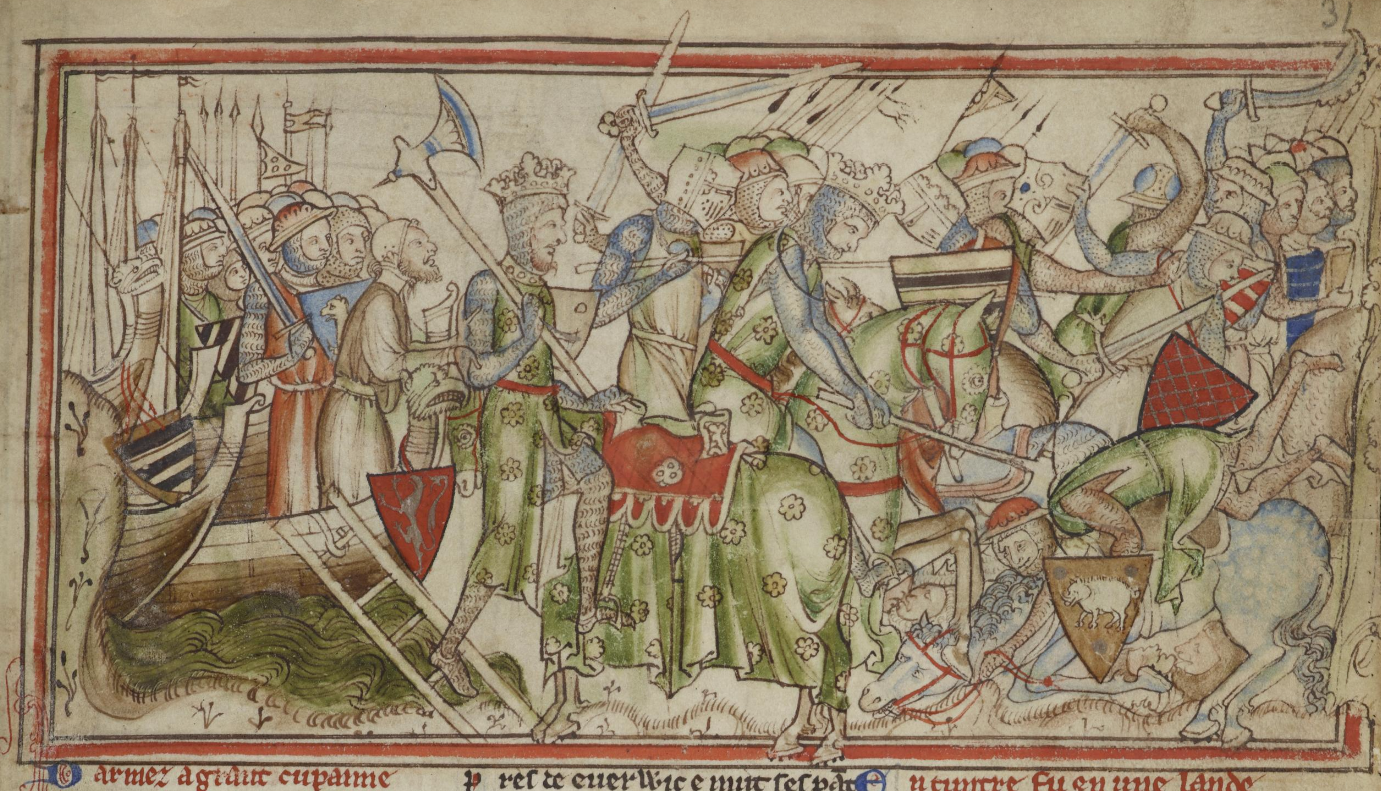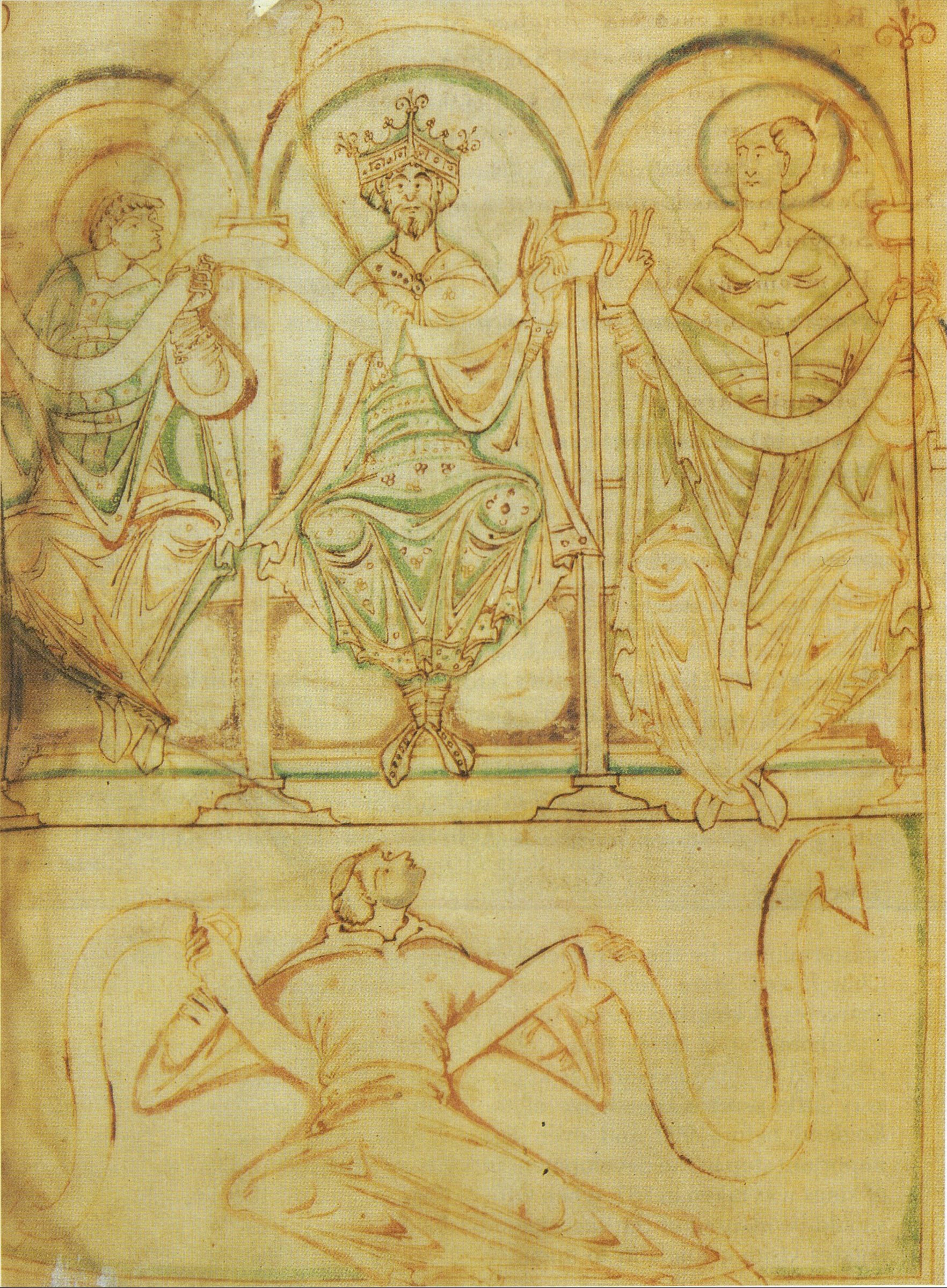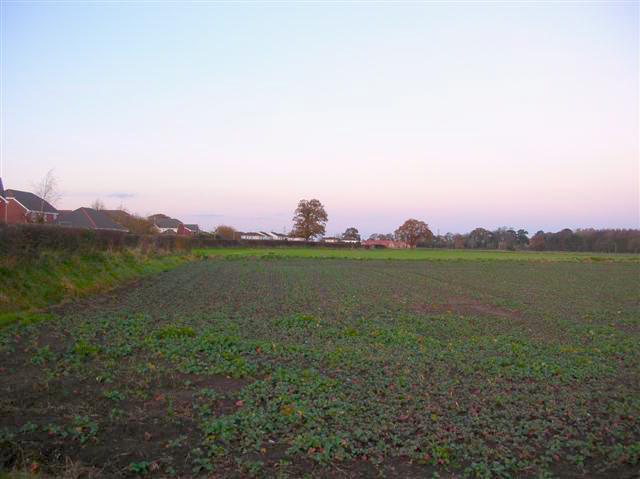|
Morcar Of Northumbria
Morcar (or Morcere) (, ) (died after 1087) was the son of Ælfgār (earl of Mercia) and brother of Ēadwine. He was the earl of Northumbria from 1065 to 1066, when William the Conqueror replaced him with Copsi. Dispute with the Godwins Morcar and his brother Ēadwine, now Earl of Mercia, assisted the Northumbrian rebels to expel Tostig Godwinson. In October 1065 the Northumbrians chose Morcar as earl at York. He at once satisfied the people of the Bernicia by making over the government of the country beyond the River Tyne to Osulf of Bamburgh, the eldest son of Eadwulf IV of Bamburgh, the Bernician earl whom Siward had slain in 1041. Marching southwards with the rebels, Morcar gathered into his forces the men of Nottingham, Derby, and Lincoln, members of the old Danish confederacy of towns, and met Ēadwine, who was at the head of a considerable force at Northampton. There the brothers and their rebel army considered proposals for peace offered to them by Earl Harold G ... [...More Info...] [...Related Items...] OR: [Wikipedia] [Google] [Baidu] |
Ælfgar, Earl Of Mercia
Ælfgar (died ) was the son of Leofric, Earl of Mercia, by his famous wife Godgifu ( Lady Godiva). He succeeded to his father's title, Earl of Mercia, and responsibilities on the latter's death in 1057. He gained the additional title of Earl of East Anglia, but also was exiled for a time. Through the first marriage of his daughter he became father-in-law to Welsh king Gruffydd ap Llywelyn. A few years after Ælfgar's death, his daughter became a widow and married Harold Godwinson, the last king of Anglo-Saxon England. War and exile Ælfgar profited from the exile of Earl Godwin of Wessex and his sons in 1051. He was given the Earldom of East Anglia, which had been that of Harold, son of Godwin. Earl Godwin and King Edward were reconciled the following year, so Harold was restored to his earldom—but not for long. At Easter 1053 Godwin died, so Harold became Earl of Wessex, and the earldom of East Anglia returned to Ælfgar.Ann Williams, 'Ælfgar, earl of Mercia (d. 1060)’ ... [...More Info...] [...Related Items...] OR: [Wikipedia] [Google] [Baidu] |
Oxford
Oxford () is a City status in the United Kingdom, cathedral city and non-metropolitan district in Oxfordshire, England, of which it is the county town. The city is home to the University of Oxford, the List of oldest universities in continuous operation, oldest university in the English-speaking world; it has buildings in every style of Architecture of England, English architecture since late History of Anglo-Saxon England, Anglo-Saxon. Oxford's industries include motor manufacturing, education, publishing, science, and information technologies. Founded in the 8th century, it was granted city status in 1542. The city is located at the confluence of the rivers Thames (locally known as the Isis) and River Cherwell, Cherwell. It had a population of in . It is north-west of London, south-east of Birmingham and north-east of Bristol. History The history of Oxford in England dates back to its original settlement in the History of Anglo-Saxon England, Saxon period. The name � ... [...More Info...] [...Related Items...] OR: [Wikipedia] [Google] [Baidu] |
Gospatric, Earl Of Northumbria
Gospatric or Cospatric (from the Cumbric "Servant of aint Patrick"), (died after 1073), was Earl of Northumbria, or of Bernicia, and later lord of sizable estates around Dunbar. His male-line descendants held the Earldom of Dunbar, later known as the Earldom of March, in south-east Scotland until 1435, and the Lordship and Earldom of Home from 1473 until the present day. Background Symeon of Durham describes Gospatric, Earl of Northumbria, as maternal grandson, through his mother Ealdgyth, of Northumbrian ealdorman Uchtred the Bold and his third wife, Ælfgifu, daughter of King Æthelred II. This follows the ancestry given in the earlier '' De obsessione Dunelmi'', in which Gospatric's father is named as Maldred, son of ''Crinan, tein'' (thegn Crínán), perhaps the Crínán of Dunkeld who was father of Scottish king Duncan I. Even were thegn Crínán the same as Crínán of Dunkeld, it is not certain Maldred was born to Duncan's mother, Bethóc, daughter of the Scot ... [...More Info...] [...Related Items...] OR: [Wikipedia] [Google] [Baidu] |
Berkhamsted
Berkhamsted ( ) is a historic market town in Hertfordshire, England, in the River Bulbourne, Bulbourne valley, north-west of London. The town is a Civil parishes in England, civil parish with a town council within the borough of Dacorum which is based in the neighbouring large new town of Hemel Hempstead. Berkhamsted, along with the adjoining village of Northchurch, is encircled by countryside, much of it in the Chiltern Hills which is an Area of Outstanding Natural Beauty (AONB). The High Street is on a pre-Roman route known by its Saxon name: Akeman Street. The earliest written reference to Berkhamsted was in 970. The settlement was recorded as a ''burbium'' (ancient borough) in the Domesday Book in 1086. The most notable event in the town's history occurred in December 1066. After William the Conqueror defeated Harold Godwinson, King Harold's Anglo-Saxon army at the Battle of Hastings, the Anglo-Saxon leadership surrendered to the Norman Conquest, Norman Military camp, enca ... [...More Info...] [...Related Items...] OR: [Wikipedia] [Google] [Baidu] |
William Of Normandy
William the Conqueror (Bates ''William the Conqueror'' p. 33– 9 September 1087), sometimes called William the Bastard, was the first Norman king of England (as William I), reigning from 1066 until his death. A descendant of Rollo, he was Duke of Normandy (as William II) from 1035 onward. By 1060, following a long struggle, his hold on Normandy was secure. In 1066, following the death of Edward the Confessor, William invaded England, leading a Franco-Norman army to victory over the Anglo-Saxon forces of Harold Godwinson at the Battle of Hastings, and suppressed subsequent English revolts in what has become known as the Norman Conquest. The rest of his life was marked by struggles to consolidate his hold over England and his continental lands, and by difficulties with his eldest son, Robert Curthose. William was the son of the unmarried Duke Robert I of Normandy and his mistress Herleva. His illegitimate status and youth caused some difficulties for him after he succeede ... [...More Info...] [...Related Items...] OR: [Wikipedia] [Google] [Baidu] |
Edgar The Ætheling
Edgar is a commonly used masculine English given name, from an Anglo-Saxon name ''Edgar'' (composed of '' ead'' "rich, prosperous" and '' gar'' "spear"). Like most Anglo-Saxon names, it fell out of use by the Late Middle Ages; it was, however, revived in the 18th century, and was popularised by its use for a character in Sir Walter Scott's '' The Bride of Lammermoor'' (1819). The name was more common in the United States than elsewhere in the Anglosphere during the 19th century. It has been a particularly fashionable name in Latin American countries since the 20th century. People with the given name * Edgar the Peaceful (942–975), king of England * Edgar the Ætheling (c. 1051 – c. 1126), last member of the Anglo-Saxon royal house of England * Edgar of Scotland (1074–1107), king of Scotland * Edgar Alaffita (born 1996), Mexican footballer * Edgar Allan (other), multiple people * Edgar Allen (other), multiple people * Edgar Angara (1934–2018), F ... [...More Info...] [...Related Items...] OR: [Wikipedia] [Google] [Baidu] |
Chester
Chester is a cathedral city in Cheshire, England, on the River Dee, Wales, River Dee, close to the England–Wales border. With a built-up area population of 92,760 in 2021, it is the most populous settlement in the borough of Cheshire West and Chester. It is also the historic county town of Cheshire and the List of Cheshire settlements by population, second-largest settlement in Cheshire after Warrington. Chester was founded in 79 AD as a "Castra, castrum" or Roman Empire, Roman fort with the name Deva Victrix during the reign of Emperor Vespasian. One of the main army camps in Roman Britain, Deva later became a major civilian settlement. In 689, Æthelred of Mercia, King Æthelred of Mercia founded the Minster Church of West Mercia, which later became Chester's first cathedral, and the Angles (tribe), Angles extended and strengthened the walls to protect the city against the Danes (Germanic tribe), Danes. Chester was one of the last cities in England to Norman conquest of Eng ... [...More Info...] [...Related Items...] OR: [Wikipedia] [Google] [Baidu] |
Ealdgyth, Daughter Of Earl Ælfgar
Ealdgyth (''fl. c''. 1057–1066), also Aldgyth or Edith in modern English, was a daughter of Ælfgar, Earl of Mercia, the wife of Gruffudd ap Llywelyn (d. 1063), ruler of all Wales, and later the wife and queen consort of Harold Godwinson, king of England in 1066.Maund, "Ealdgyth (''fl. c''.1057–1066)" She was described by William of Jumièges as a considerable beauty. Family Ealdgyth was the daughter of Ælfgar, who had been earl of East Anglia a number of times in the 1050s and was appointed earl of Mercia in ''c''. 1057, in succession of his father Earl Leofric. Ælfgar's wife Ælfgifu was probably her mother, and Eadwine, the later earl of Mercia, and Morcar, earl of Northumbria, were her brothers. In 1055, Ælfgar was exiled on the charge of treason. He went to Ireland to muster troops and formed an alliance with Gruffudd ap Llywelyn, who had been king of Gwynedd (1039–1055) but assumed the sovereignty of all Wales in 1055. Ælfgar and Gruffudd invaded England an ... [...More Info...] [...Related Items...] OR: [Wikipedia] [Google] [Baidu] |
Battle Of Hastings
The Battle of Hastings was fought on 14 October 1066 between the Norman-French army of William, Duke of Normandy, and an English army under the Anglo-Saxon King Harold Godwinson, beginning the Norman Conquest of England. It took place approximately northwest of Hastings, close to the present-day town of Battle, East Sussex, and was a decisive Norman victory. The background to the battle was the death of the childless King Edward the Confessor in January 1066, which set up a succession struggle between several claimants to his throne. Harold was crowned king shortly after Edward's death but faced invasions by William, his own brother Tostig, and the Norwegian king Harald Hardrada (Harold III of Norway). Hardrada and Tostig defeated a hastily gathered army of Englishmen at the Battle of Fulford on 20 September 1066. They were in turn defeated by Harold at the Battle of Stamford Bridge on 25 September. The deaths of Tostig and Hardrada at Stamford Bridge left William as ... [...More Info...] [...Related Items...] OR: [Wikipedia] [Google] [Baidu] |
Battle Of Stamford Bridge
The Battle of Stamford Bridge () took place at the village of Stamford Bridge, East Riding of Yorkshire, in England, on 25 September 1066, between an English army under Harold Godwinson, King Harold Godwinson and an invading Norwegian force led by Harald Hardrada, King Harald Hardrada and the English king's brother Tostig Godwinson. After a bloody battle, both Hardrada and Tostig, along with most of the Norwegians, were killed. Although Harold Godwinson repelled the Norwegian invaders, his army was defeated by the Normans at Battle of Hastings, Hastings less than three weeks later. The battle has traditionally been presented as symbolising the end of the Viking Age, although major Scandinavian campaigns in Britain and Ireland occurred in the following decades, such as those of Sweyn II of Denmark, King Sweyn Estrithson of Denmark in 1069–1070 and Magnus III of Norway, King Magnus Barefoot of Norway in 1098 and 1102–1103. Background The death of King Edward the Confessor of ... [...More Info...] [...Related Items...] OR: [Wikipedia] [Google] [Baidu] |
Battle Of Fulford
The Battle of Fulford was fought on the outskirts of the village of Fulford, just south of York in England, on 20 September 1066, when King Harald III of Norway, also known as ''Harald Hardrada'', a claimant to the English throne and Tostig Godwinson, his English ally, fought and defeated the Northern Earls Edwin and Morcar. Hardrada's army consisted of allies from Orkney and a contingent with Tostig, as well as those coming from Norway. They crossed the sea in a fleet of ships and made their base east of York at Riccall. On 20 September 1066 the Vikings advanced towards York. The largely inexperienced Saxon army led by Morcar at York and Edwin at Tadcaster moved to block the invaders. The Anglo-Saxon Chronicle says that the opposing armies met on the east bank of the River Ouse and that initially the Saxons caused heavy losses on the Viking army. Ultimately, the Norse army overwhelmed the Saxon army although the earls themselves survived this defeat. After winning, the vict ... [...More Info...] [...Related Items...] OR: [Wikipedia] [Google] [Baidu] |
Northumbria
Northumbria () was an early medieval Heptarchy, kingdom in what is now Northern England and Scottish Lowlands, South Scotland. The name derives from the Old English meaning "the people or province north of the Humber", as opposed to the Southumbria, people south of the Humber, Humber Estuary. What was to become Northumbria started as two kingdoms, Deira in the south and Bernicia in the north. Conflict in the first half of the seventh century ended with the murder of the last king of Deira in 651, and Northumbria was thereafter unified under Bernician kings. At its height, the kingdom extended from the Humber, Peak District and the River Mersey on the south to the Firth of Forth on the north. Northumbria ceased to be an independent kingdom in the mid-tenth century when Deira was conquered by the Danelaw, Danes and formed into the Kingdom of York. The rump Earl of Northumbria, Earldom of Bamburgh maintained control of Bernicia for a period of time; however, the area north of R ... [...More Info...] [...Related Items...] OR: [Wikipedia] [Google] [Baidu] |







